Metal heat treatment in ancient China: annealing, quenching, normalizing and tempering
China is one of the older ancient civilizations, but the appearance logging out West Asian countries at the history of metal use and smelting. Depending on the strong intelligence and practical experience of Chinese ancestors, they developed a unique path in metal smelting and then made metal products and applications of China ancient far advantage other locations.
Metallurgical Technology of China has rapidly developed and transcended other competitors and has a strong relationship with innovation and creativity in metal heat treatment in early history.

Due to obtaining only a few materials and technical lower at metallurgical an early age, products’ properties aren’t good. These ancient technicians with many varied methods to widen the properties of materials and change their parameters, multiple metal processing and steel manufacturing processes were innovative and formed extremely characteristic heat treatment processes and technical of ancient.
They have achieved serial success at heat treatment, for instance, annealing, quenching, carburizing, rubbing, gilding, tin plating, etc.
To comprehensive understanding metal heat treatment process of Chinese history, synthesis analysis of ancient files and results of archeology is in demand.
Since heat treatment technology is generally a master’s class technology these relative files are incomplete. A total analysis of the metal process of ancient depends on the debris of archeology and history files.
We are trying to simply analyze heat treatment including annealing, quenching, normalizing, and tempering with modern concepts.
Annealing
1. copper and its alloys
The history of human use of copper can be traced back to before 7250 BC. The annealing process was invented earlier, initially in the natural copper manufacturing of simple artifacts obtained by chance in the processing, and later gradually developed into an important heat treatment process in the processing of copper and its alloy forgings. South Turkmenistan’s new culture site excavated pure copper knife processing using annealing, its age can be traced back to 4000 years ago.
The invention of the annealing process should be regarded as the beginning of human metal heat treatment. Studies have shown that early copper and its alloys are unsuitable for large-form variable processing without annealing. Copper and its alloys are prone to work hardening in the middle of annealing to produce recrystallization so that the copper alloy softened for further processing, this technology is widely used later in the manufacture of weapons and household utensils.
The use of the forging and annealing process of bronze processing may have appeared before 3500 BC.
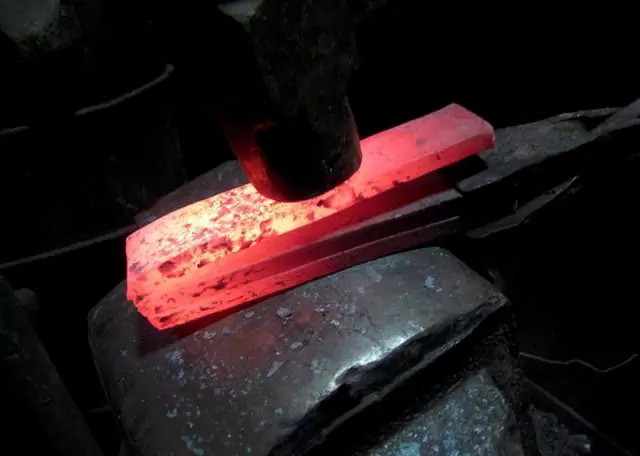
The origin of ancient Chinese copper culture is relatively late, and the application of copper and its alloys by Chinese ancestors may be more than 3,000 years later than that of Ancient Mesopotamia. Based on the early artifacts excavated, metallurgy was believed to have sprouted in China around 5000 BC.
During the Longshan culture period in the second half of the third millennium B.C., there were more than 50 excavated copper artifacts in 11 categories, and the metal processes used were casting, forging, and annealing.
Former Beijing Iron and Steel Institute of metallurgical history of the group by Gansu Yongjing Qin Weijia site unearthed about 1700 BC bronze cone analysis shows that its base structure for recrystallization α solid solution grain coarse α + δ eutectic structure along the processing direction deformation, it is clear that the structure has undergone recrystallization annealing.
Ancient weapons such as swords, ji, axes, etc. need to be forged to become sharp edges, to prevent cracking in the forging process shall be used between forging and annealing treatment. “Forging is spear” is the Shang and Zhou period about the production of weapons records, and the effective application of annealing technology to produce a complex, sharp, and exceptionally sharp sword.
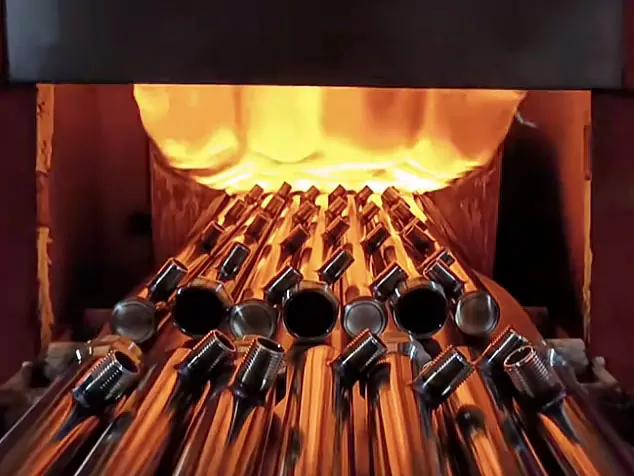
2. Metal foil annealing
Natural gold is mainly derived from natural gold nuggets and frits of alluvial gold. An important use of gold is to make very thin gold leaves or sheets to decorate objects.
In early times, cold working was often used to reduce the thickness of gold sheets to a few millimeters. Gold products unearthed in China are mostly ornaments, such as gold armlets, gold earrings, gold earrings, gold leaves, etc. There are also gold foils in the unearthed remains of the Shang Dynasty.
The gold foil unearthed from the tomb of Dashikong Yin in Anyang has a thickness of 0.01±0.001mm, which was analyzed by the Metallurgical History Department of the former Beijing Iron and Steel Institute, with uniform grain size and straight grain boundaries, and is believed to have been made by the forging and annealing process.
The need for large-scale decorations in early China, such as in architecture, prompted Chinese craftsmen to apply annealing technology in the processing of gold foil. The application of the annealing process made gold foil available in China during the Shang Dynasty.
Ancient Chinese gold foil (also known as gold thin) manufacturing, in the “T’ien-kung k’ai-wu”, “hui shih so yen” and other ancient books are recorded, that is, after the initial forging of the gold sheet, layers stacked into the special ebony paper tied into bundles, and be forged and annealed.
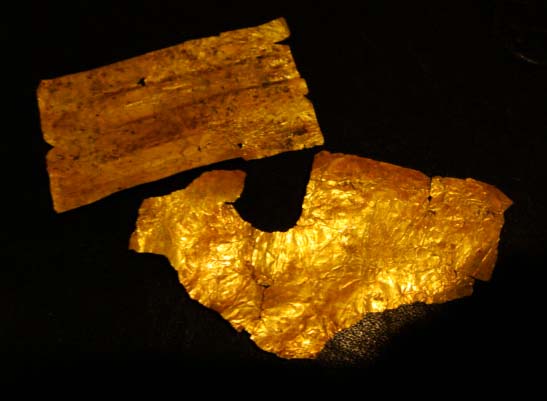
Its intermediate annealing treatment may be placed in a charcoal furnace with the aureole paper, heated at about 100 ℃ to eliminate work-hardening. The final annealing treatment would be utilizing the residual heat from the forging and slowly cooling the gold sheets with the aureole to room temperature.
The unique process of spacing, bundling, forging, and annealing of ebony paper has made it possible to produce thinner and more uniform gold foil than is possible in other countries.
The processing of gold foil is still circulating in Beijing, Fujian, Zhejiang, and Guangdong in modern times. Besides gold foil, there are also records about silver foil in ancient China. Silver foil was mainly used for the decoration of artifacts. The silver ornaments on the lacquer boxes unearthed from the Western Han Dynasty tombs in Wusha Tomb, Guanghua, Hubei are believed to be made of silver foil.
Yuan Dynasty Tao Zongyi “nan ts’un ch’o keng lu” record: “Where the ware for the tithe …… to gold thin or silver thin according to the silversmiths with paper paste cover, placed in the gold and silver thin inside, one by one spinning fine cut to take. Lay has been, spinning paint, new sheep wipe firmly.” Tin foil is a large amount of metal foil its biggest use is the production of paper money and decoration. The manufacture of tin foil is also reported in ancient books.
Its processing production also uses layers of stacked forging and annealing, the difference is that the ancients recognized that the surface of the tin is easy to forms compartmentalization (i.e., oxidation layer), and therefore does not take the method of paper spacing between the pieces of tin. In addition, in the annealing and developed steam heating technology. Steam heating can make the temperature control slightly above 100 ℃ can obtain high ductility and avoid excessive oxidation of tin foil.
3. Annealing of iron and steel
Similar to copper smelting, the earliest cast iron was not found in China, e.g., a white iron billet from 2000-3000 B.C. unearthed at Choitepe, which is 3.5% C-0.45% P-0.16% S pig iron, and there are also reports of early high-phosphorus pig iron.
However, it is noteworthy that no early artifacts made of pig iron have been found in these areas. This is mainly due to their inability to handle the hard and brittle pig iron. The invention of iron casting in China in the sixth and seventh centuries B.C.E. was an important contribution by ancient craftsmen to the development of iron and steel technology, which enabled China to enter the ranks of the advanced countries in large-scale iron production. However, the large-scale application and popularization of cast iron relied heavily on the Chinese skill of annealing.
Ancient Chinese craftsmen developed a series of treatments adapted to the annealing of pig iron, mature iron, and steel by controlling the conditions of heating, cooling, and atmosphere, which can be generally categorized as annealing of cast iron and annealing of steel. In addition, they also developed the preparation of cast iron decarbonized steel, black heart, and white heart malleable cast iron decarbonization annealing treatment methods. These are all significant advances in the field of metal heat treatment in ancient China.
3.1 Annealing of cast iron and its Structure
Flocculated graphite structure
Confirmed by a large number of archaeological, the invention of Chinese cast iron in the Spring and Autumn period. The earliest dated cast iron fragments excavated so far were unearthed in the Jin culture tombs in Tianma-Qucun, Shanxi. More than a dozen products made of white cast iron belonging to the early Warring States period have also been unearthed. To overcome the brittleness of white cast iron, Chinese craftsmen invented the forging annealing technique for cast iron around the fifth century BC.
In Henan, Luoyang unearthed an iron shovel and an empty first iron hoe, the metallographic examination shows that its base structure is for ferrite, and its graphite structure is for the more perfect flocculent annealed graphite. According to the analysis of it about after 900 ℃ or slightly higher temperature, for a long time of annealing, the decomposition of carburize to get the flocculent graphite, so that the white iron becomes a typical malleable cast iron, the emergence of Europe with the same type of malleable cast iron is in 1720 after.
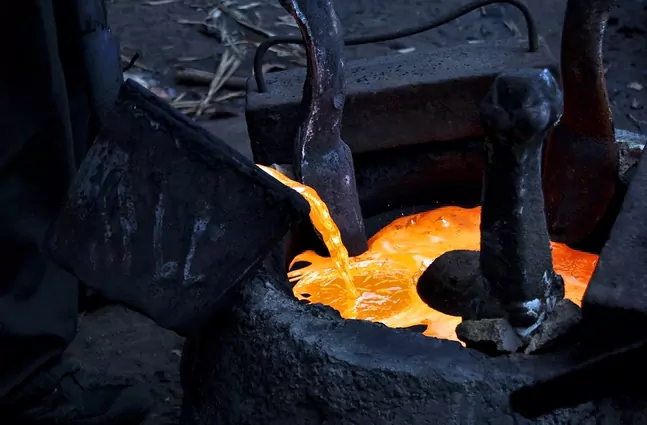
Gray cast iron structure
Gray iron internal graphite into flakes, is the better performance of cast iron, even today, gray iron is still one of the overwhelming majority of sub-eutectic iron alloys. Contemporary gray iron is achieved by adding graphitization-promoting elements and controlling the cooling rate. In ancient China, gray iron structure was obtained very early.
Beijing Iron and Steel Institute of Metallurgical History Teaching and Research department had a census of the Han Dynasty iron, and found that the casting of pig iron in the gray iron accounted for 21%, tinplate iron(SPTE) accounted for 4%, they believe that the production of gray iron in the Han Dynasty has been a mature process, tinplate iron is the production of gray iron by chance.
Ancient craftsmen seem to have known the performance characteristics of gray iron, excavated in Manchu Han Tomb 112 BC axle, with gray iron, structure has graphite, which can play a wear-resistant and friction reduction role, which is the earliest excavated gray iron parts.
Because the ancient grey iron, silicon content is lower than modern grey iron, its structure is likely to be grey annealed annealing treatment products. Because such a large amount of Han dynasty gray iron relies on the control of solidification of the cooling rate get seems to be somewhat incredible.
Cast iron ductile structure
Ancient craftsmen probably used the method of annealing cast iron at high temperatures in kilns to obtain a ductile structure. Spheroidal graphite was discovered during the identification of iron objects in the Hanwei kiln collection at Mianchi. Chinese archaeologists have shown through analysis of certain iron objects with ductile structures that the structural characteristics of spheroidal graphite are no different from those of modern graphite obtained by adding a spheroidalizing agent.
Moreover, a census report on the analysis of 188 iron objects from the Han Dynasty in Henan Province showed that the proportion of ductile iron in ancient cast iron was 1.5%, which compares with 4.5% in China in 1981, indicating that annealing was already a stable process at that time. In contrast, it was only after metallurgical observation of accidentally obtained high-ductility cast iron in 1942 that other researchers went on to determine the ductile annealing process for cast iron.
3.2 Annealing of steel
Meteor iron is a high-iron-nickel alloy. Humans living in the Stone Age began to use this “god-given” metal more than 3,000 BC. To make knives or small items, they used annealing or hot forging processes. China has discovered a total of seven meteorite artifacts in the Shang and Zhou dynasty’s ruins. Among them, the oldest one belongs to the 14th century BC, an iron-edged copper ax that was forged and processed.
The use of annealing processes in early artificial iron smelting has been proven. To carry out large-scale deformation processing of this kind of bloomery iron and bloomery iron carburizing steel, the annealing process is indispensable. Intermediate annealing of forged steel parts is an important process in processing and may have been adopted soon after the emergence of artificial iron smelting. Annealing as a final heat treatment appears to have been used by ancient craftsmen as well.
The armor pieces of the same period unearthed from Han Tomb No. 1 in Mancheng and Ershijiazi in Hohhot are all bloomery iron materials. The microstructure of the surface layer is ferrite structure, and the final treatment process is annealing.
The former Metallurgical History Teaching and Research Office of Beijing Iron and Steel Institute conducted a metallographic survey on 188 Han Dynasty iron tools unearthed in Henan. The results showed that 40% of the iron tools surveyed were steel parts made from decarburized cast iron. The microstructure of most agricultural tools is pearlite and cementite, and some of the cementite has been spheroidized.
It can be seen from this that ancient craftsmen annealed medium and high carbon steel for a long time at around 723°C. They used this method to obtain a spheroidized annealed structure in some cases.
The steel-making methods of ancient Chinese craftsmen not only used carburizing and decarburizing methods but also steel-filling methods, hundred-refining methods, etc. The annealing treatment of steel has gradually become one of the most conventional treatment methods.
In “T’ien-kung k’ai-wu”, Song Yingxing refers to the annealing treatment of hardened steel parts as “anti-heating”: When sawing, wrought iron is forged into thin strips, neither steel nor hardened. After the fire has subsided, add a cold hammer to harden it frequently. The annealing and softening of quenched steel parts are called “regression of hardening”. After softening, proceed to the next step of processing.
Quenching technology
Quenching is a landmark heat treatment technology. The quenching technology started very early. The structure of the iron knives and arrowheads unearthed from the Harshitat site in Central Europe is in a quenched state. This site dates from more than 1,000 BC. Two axes quenched before 900 BC were unearthed in Egypt, and their blades had martensite.
Homer’s epic poem “The Odyssey” of the eighth century BC records the quenching process: “The blacksmith dipped the hot ax into cold water, and it hissed violently.” The adoption of quenching technology in ancient China was later than that in West Asia and Europe.
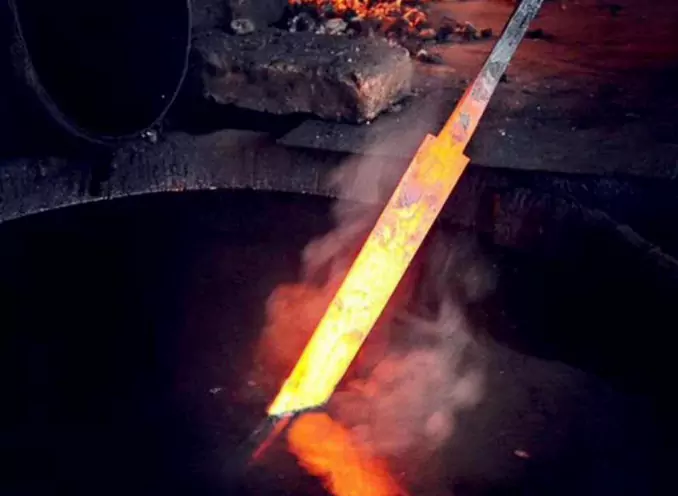
According to archaeological analysis of cultural relics, ancient Chinese quenching technology may have been first used in bloomery iron smelting. One of the hardened objects excavated by archeology is a steel sword unearthed from the late Warring States period site in Wuyangtang Village, Yanxiadu, Yixian County, Hebei Province. Its carbon content is 0.5% to 0.6%. The entire sword is composed of alternating high-carbon layers and low-carbon layers, and the blade is mainly composed of quenched martensite. This is a typical quenching structure of bloomery iron carburized steel stack forging.
In addition to being applied to steel, ancient Chinese quenching technology may also have been applied to copper alloys. Some studies believe that some ancient Chinese weapons were quenched. Quenching treatment of copper alloy can improve its processability and reduce brittleness. In some situations with a high alloy ratio, quenching can provide a high solid solution strengthening effect.
Archaeological data also show that the Etruscans in northwest Italy in the fourth and fifth centuries BC and the Samaritan people of the Volga River in the fourth and second centuries BC also used this method in high-tin bronze mirrors. Therefore, it can be considered that China and Italy applied the quenching technology of bronzes almost at the same time.
Although ancient Chinese ancestors used the quenching process late, they were very advanced in selecting quenching agents and controlling heat, such as using a variety of quenching agents, pre-cooling quenching, and partial quenching processes.
1. Coolant for quenching
Ancient Chinese ancestors have known for a long time that different quenching agents have different effects. According to “Historical Records·Biography of Su Qin” Sima Zhen’s “Suoyin” quoted from “Jin Taikang Geography” “There is Longquan water in Xiping, Runan, which can quench swords and is very strong, so there is a Longquan sword.”
There are records showing that Chinese craftsmen have already “quenched swords” with water. The impact on water quality was documented during the Three Kingdoms period. “t’ai p’ing yü lan” quotes “p’u yüan’s Biography” and says that p’u yüan’s “unusual method of melting metal to make utensils.” When the sword was made, he said that the Han River was blunt and weak and could not be quenched. The Shu River was so strong that he ordered people to fetch water from Chengdu. “The influence of water quality of different rivers on quenching is undeniable, but it may be overemphasized in “p’u yüan Biography”.
However, what is interesting is that fifteen centuries later, similar to the above story, there was an incident in Western countries where the United States went to England to obtain water for quenching.
The earliest use of oil as a quenching agent was in Europe. Aristotle and Pliny the Elder (1st century AD) mentioned the use of oil for quenching. The earliest record of the use of oil quenching in China was Ch’i wu huai wen of the Southern and Northern Dynasties around 550 AD. “History of the North·Biography of Art” points out that “Huaiwen made iron swords by melted pig iron and poured onto the wrought iron, and it would become hard after several nights, to allow carbon to penetrate into the wrought iron and increase the carbon content of the wrought iron. Then it is quenched into steel using animal urine and animal fat respectively. It can also be seen in the article that Ch’i Wu Huai Wen creatively proposed the quenching process using animal urine.
Animals’ urine contains salt water and has a strong cooling capacity and deep hardening layer. What people are interested in is how to understand the “bathing in animals urine, quenching with the fat of the animals” mentioned in the article. If it is double liquid quenching, this quenching technology that appeared in the sixth century AD is an important development. There are also records of using blood and mixture to quench fire in ancient Chinese books.
“New Book of Tang” says: “When Yu’s sword was cast… the horse’s blood was quenched…” Now it seems that the selection of many quenching agents at that time was not necessarily correct, and there was a lot of superstition in it.
2. Partial quenching
There are not many descriptions of local quenching in ancient documents, but analysis of archaeological objects shows that this technique was commonly used to treat cutting tools in ancient China. Metallographic analysis of the four chisels unearthed from the Chu King’s Mausoleum in Shizishan, Xuzhou showed that the four chisels had undergone partial quenching treatment on the blade heads to obtain a hard blade and tough blade body.
Analysis of the Huanshou steel sword unearthed from the Han tomb in Cangshan, Shandong, the steel sword from the Han tomb in Fufeng, Shaanxi, and the book knife decorated with gold of Liu Sheng from the Han Dynasty also showed that martensite was only observed on the blade of these swords, and no quenching structure was found on the ridge of the sword. It can be seen that Chinese ancestors had mastered the local quenching technology as late as the second century BC.
3. Pre-cooling and quenching
The research and exploration work done by ancient Chinese craftsmen on quenching technology not only invented quenching agents but also made inventions in controlling heat, such as pre-cooling quenching. Precooling and quenching are beneficial to reducing the distortion of the tool and improving the strength and toughness of the tool.
Sung Ying Hsing’s “t’ien kung k’ai wu” of the Ming Dynasty contains a record of the use of pre-cooling and quenching technology: “At this time, first use a quenched hard steel chisel to draw rows of vertical and diagonal lines on the surface of the file blank. Pay attention to the diagonal cutting edge when cutting the file lines, so that the grooves can have a flame-like edge. After digging, heat the file red, take it out, cool it slightly, and put it in water for quenching. The file will be successful at this time.” Among, “cool it slightly” is the pre-cooling and quenching process.
Tempering technology
Tempering treatment is a process developed due to the brittleness of quenching. In the early ages of artificial iron smelting, people did not necessarily feel the necessity of tempering strongly. The main reason is that the carbon content of bloomery iron is usually not high, and sometimes tempering is not required, and even quenching cannot achieve significant strengthening effects. Other countries started to implement purposeful tempering very late.
Relatively speaking, ancient Chinese ancestors realized the benefits of tempering earlier. To obtain the hardening effect while avoiding brittle fracture, the Chinese may have consciously adopted tempering very early. From the description of the sword in “Mo Tzu”: “It penetrates when thrust, breaks when struck, and does not break when struck from the side.” It can be seen that the steel swords in the Spring and Autumn Periods of China already had good strength and toughness. Whether the process used is low-temperature tempering remains to be confirmed by further research.
Many later Chinese documents describe the unusually high elasticity of steel swords made in China. For example, “Meng hsi pi t’an” mentions that there was a person who “brings a sword, and it can be placed in a box, and it can be straightened again.” The process used in these steel swords is high-temperature tempering. Archeology of physical objects also suggests that the high-temperature tempering process may have been applied in the late Spring and Autumn Periods.
Analysis of the steel sword unearthed from Yangjiashan, Changsha, and Hunan, shows that its carbon content is about 0.5%, and its structure is considered to be equivalent to the high-temperature tempered structure. This carbon content is right up there with today’s spring steels. If confirmed by this research, the object, dating from the sixth century BC, maybe the earliest high-temperature tempered object unearthed to date.
Normalizing technology
Normalizing in the true sense appeared after people understood the iron-carbon phase diagram, that is, after Austin in the UK made the iron-carbon phase diagram in 1888, air cooling was used for normalizing cooling. In ancient times, quenched objects were too hard, and annealed objects were too soft. Air cooling with moderate cooling speed saved both money and power. China had this craft during the Warring States Period.
For example, through the analysis of the spears and arrowheads excavated in the Secondary Capital of Yan in the late Warring States Period, it was found that the two iron tools were bloomery iron carburized steel products, with carbon contents of 0.20% and 0.25% respectively. The internal structure is composed of ferrite and pearlite, and the pearlite has a wide interlamellar spacing. Metallographic analysis results show that this is similar to the structure obtained by air cooling or normalizing treatment of today’s austenite. It can be considered that it is a structure obtained by air cooling after heating at a temperature higher than Ac1. Craftsmen in the Han Dynasty in China decarburized cast iron to obtain low-carbon steel and medium-carbon steel, which made many utensils without quenching and used this process.
Conclusion
The archaeological research on metal heat treatment in China needs to be in-depth. According to preliminary analysis, it can be seen that ancient China developed a relatively complete experimental heat treatment technology including annealing, quenching, normalizing, and tempering.
China’s use of annealing on copper and its alloys is more than ten centuries later than in West Asia. Due to the unique annealing technology, China has had gold and silver foil since the Shang Dynasty, and China has a high level of traditional tin foil manufacturing technology.
Ancient Chinese craftsmen used the technology of annealing iron and steel to obtain the flocculent graphite structure, gray structure, and ductile structure that were only obtained in modern times in Europe. It improved the microstructure of steel products and greatly promoted the development of ancient China’s steel manufacturing industry.
The adoption of quenching technology in China was late, but later it showed high technological skills in the selection of quenching agents, partial quenching, pre-cooling quenching, etc. In addition, Chinese craftsmen may have applied tempering and normalizing techniques during the Warring States Period, expanding the uses of ancient Chinese steel products.